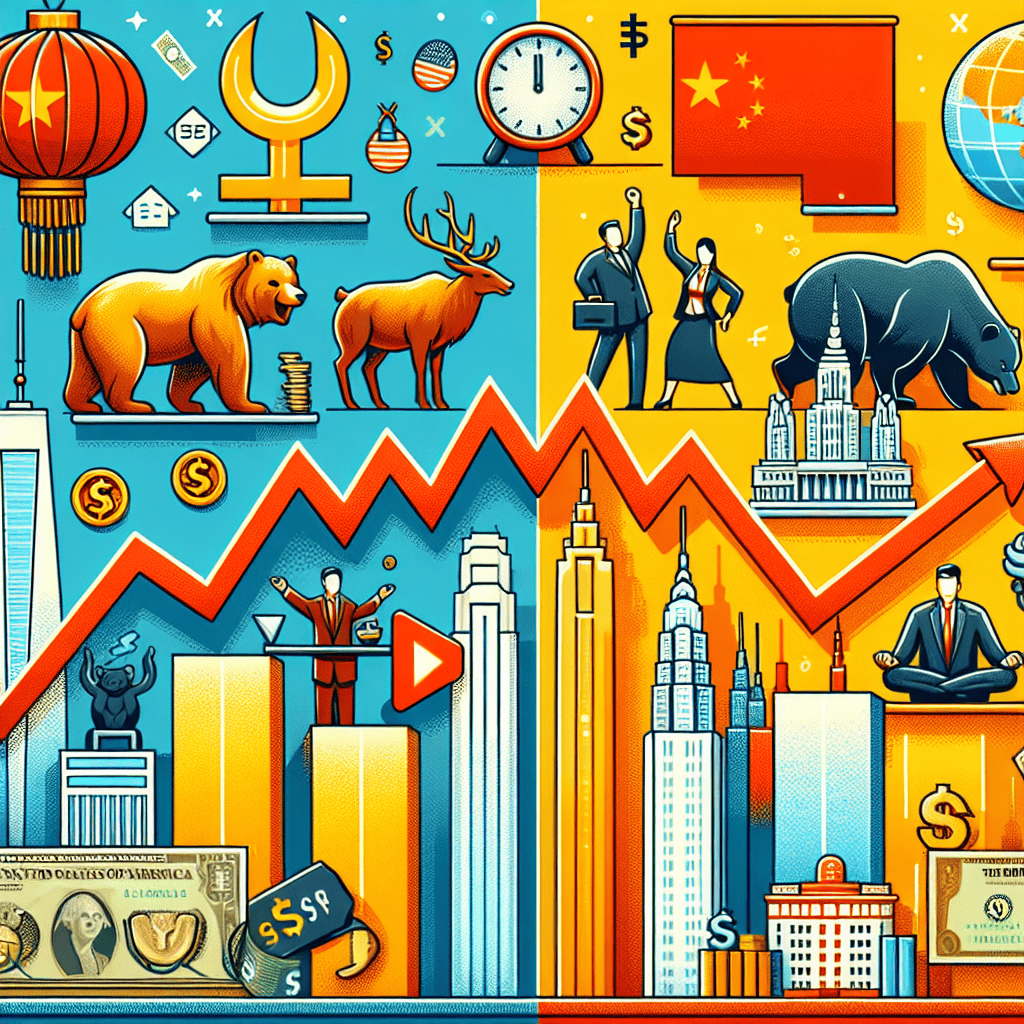“Global Shifts: China’s Easing, America’s Surge”
Introduction
In the latest Morning Brief, global financial markets are closely monitoring significant developments as China signals potential interest rate cuts to stimulate its slowing economy, while the United States continues to exhibit robust economic growth. As Beijing grapples with economic challenges, including sluggish consumer demand and a struggling property sector, policymakers are considering monetary easing to bolster economic activity. Meanwhile, across the Pacific, the U.S. economy demonstrates resilience, driven by strong consumer spending and a buoyant labor market. These contrasting economic narratives underscore the divergent paths of the world’s two largest economies, with implications for global trade, investment, and financial stability.
China’s Strategic Rate Cuts: Implications for Global Markets
In recent developments, China is preparing to implement strategic rate cuts, a move that has significant implications for global markets. This decision comes at a time when the United States economy is demonstrating robust growth, creating a complex interplay between the world’s two largest economies. As China navigates its economic challenges, the anticipated rate cuts are aimed at stimulating domestic growth and countering the effects of a slowing economy. This strategic maneuver is expected to have far-reaching consequences, not only for China but also for international markets that are closely intertwined with its economic health.
China’s decision to cut rates is primarily driven by the need to bolster its economic momentum, which has been showing signs of deceleration. The country’s manufacturing sector, a critical component of its economic engine, has been experiencing a slowdown, prompting policymakers to take decisive action. By reducing interest rates, China aims to lower borrowing costs, thereby encouraging investment and consumer spending. This move is also intended to support the real estate sector, which has been under pressure due to regulatory tightening and declining property sales. Consequently, these rate cuts are expected to provide a much-needed boost to the domestic economy, fostering a more favorable environment for growth.
However, the implications of China’s rate cuts extend beyond its borders, influencing global markets in various ways. For one, lower interest rates in China could lead to a depreciation of the yuan, making Chinese exports more competitive on the international stage. This could potentially impact other exporting nations, particularly those in Asia, as they may face increased competition in global markets. Additionally, the rate cuts could affect capital flows, as investors seek higher returns in other regions, potentially leading to increased volatility in emerging markets.
Meanwhile, the United States economy continues to thrive, presenting a stark contrast to China’s current economic landscape. The US has been experiencing strong economic growth, driven by robust consumer spending, a resilient labor market, and technological advancements. This economic vigor has been further supported by fiscal policies that have encouraged investment and innovation. As a result, the US dollar has remained strong, attracting global investors seeking stability and higher returns.
The juxtaposition of China’s rate cuts and the thriving US economy creates a dynamic environment for global markets. Investors and policymakers alike are closely monitoring these developments, as they could influence international trade, investment strategies, and economic policies. For instance, the divergence in monetary policies between China and the US may lead to shifts in currency valuations, affecting trade balances and capital flows. Moreover, the interplay between these two economic giants could have implications for global supply chains, as businesses adjust to changing economic conditions and competitive pressures.
In conclusion, China’s strategic rate cuts are poised to have significant implications for global markets, as they seek to revitalize the domestic economy and address ongoing challenges. At the same time, the thriving US economy presents a contrasting narrative, highlighting the complexities of the current global economic landscape. As these developments unfold, market participants and policymakers will need to navigate the evolving dynamics, balancing opportunities and risks in an interconnected world. The interplay between China’s rate cuts and the US economic strength will undoubtedly shape the trajectory of global markets in the coming months, underscoring the importance of strategic decision-making in an increasingly complex economic environment.
US Economic Growth: Key Drivers and Future Outlook
In recent months, the global economic landscape has been marked by contrasting developments in major economies, with China preparing to implement rate cuts while the United States continues to experience robust economic growth. The US economy, in particular, has demonstrated remarkable resilience, driven by several key factors that have contributed to its thriving state. Understanding these drivers and the future outlook for the US economy is essential for stakeholders and policymakers alike.
One of the primary drivers of US economic growth has been consumer spending, which accounts for a significant portion of the country’s GDP. With unemployment rates remaining low and wage growth showing positive trends, consumer confidence has been bolstered, leading to increased spending on goods and services. This surge in consumer activity has provided a substantial boost to various sectors, including retail, hospitality, and entertainment, thereby fueling overall economic expansion.
In addition to consumer spending, technological innovation has played a pivotal role in propelling the US economy forward. The rapid advancement of technology has not only enhanced productivity across industries but has also spurred the creation of new markets and opportunities. The tech sector, in particular, has been a major contributor to economic growth, with companies investing heavily in research and development to maintain a competitive edge. This continuous innovation cycle has led to the emergence of cutting-edge products and services, further stimulating economic activity.
Moreover, the US economy has benefited from a favorable business environment characterized by supportive fiscal and monetary policies. Tax reforms and deregulation efforts have encouraged business investment, leading to job creation and increased economic output. The Federal Reserve’s monetary policy, aimed at maintaining low interest rates, has also facilitated borrowing and investment, providing businesses with the necessary capital to expand operations and drive growth.
While these factors have contributed to the current economic prosperity, it is important to consider the future outlook for the US economy. One potential challenge is the ongoing trade tensions with major global partners, which could impact export markets and disrupt supply chains. However, efforts to negotiate trade agreements and resolve disputes may mitigate these risks, allowing the US to maintain its competitive position in the global market.
Furthermore, the labor market’s ability to sustain growth remains a critical consideration. As the economy continues to expand, the demand for skilled labor is likely to increase, potentially leading to labor shortages in certain sectors. Addressing this issue through workforce development initiatives and education programs will be crucial to ensuring that the labor market can support future economic growth.
In conclusion, the US economy’s current thriving state can be attributed to a combination of strong consumer spending, technological innovation, and a supportive business environment. While challenges such as trade tensions and labor market constraints may pose risks, the overall outlook remains positive. By continuing to foster innovation, invest in workforce development, and maintain favorable economic policies, the US is well-positioned to sustain its growth trajectory in the coming years. As China prepares for rate cuts to stimulate its own economy, the contrasting economic strategies of these two global powerhouses will undoubtedly shape the future of the global economic landscape.
Comparing Economic Strategies: China vs. US
In the ever-evolving landscape of global economics, the strategies employed by major economies such as China and the United States offer a fascinating study in contrasts. As China prepares to implement rate cuts, the United States continues to experience robust economic growth, highlighting the divergent paths these two economic powerhouses are taking in response to their unique challenges and opportunities.
China’s decision to prepare for rate cuts is a strategic move aimed at stimulating its slowing economy. The Chinese government is keenly aware of the need to bolster domestic consumption and investment, particularly in the face of external pressures such as trade tensions and a sluggish global economy. By reducing interest rates, China aims to lower borrowing costs for businesses and consumers, thereby encouraging spending and investment. This approach is consistent with China’s broader economic strategy, which emphasizes state intervention and policy-driven growth to maintain stability and achieve long-term development goals.
In contrast, the United States is currently experiencing a period of economic prosperity, characterized by strong job growth, rising consumer confidence, and robust corporate earnings. This thriving economic environment can be attributed to a combination of factors, including fiscal stimulus measures, a resilient labor market, and technological innovation. The U.S. Federal Reserve, in response to this economic strength, has maintained a cautious approach to interest rates, opting to keep them relatively stable to avoid overheating the economy. This strategy reflects the U.S. preference for market-driven growth, where the private sector plays a pivotal role in driving economic expansion.
While both China and the United States are focused on sustaining economic growth, their differing approaches underscore the unique challenges each faces. China’s reliance on rate cuts highlights its need to address structural issues within its economy, such as high levels of corporate debt and an aging population. By stimulating domestic demand, China hopes to transition from an export-driven economy to one that is more balanced and sustainable. However, this approach is not without risks, as excessive rate cuts could lead to asset bubbles and financial instability.
On the other hand, the United States’ economic strategy is not without its own set of challenges. The current economic expansion, while impressive, raises concerns about income inequality and the sustainability of growth in the long term. Additionally, geopolitical tensions and trade disputes pose potential risks to the U.S. economy, necessitating a careful balancing act by policymakers to maintain momentum while addressing these vulnerabilities.
In conclusion, the economic strategies of China and the United States reflect their distinct priorities and challenges. China’s preparation for rate cuts is a testament to its proactive approach in managing economic headwinds, while the United States’ thriving economy showcases the benefits of a market-driven model. As these two nations continue to navigate the complexities of the global economy, their strategies will undoubtedly evolve, offering valuable insights into the dynamic interplay between policy decisions and economic outcomes. By examining these contrasting approaches, we gain a deeper understanding of the diverse paths to economic prosperity and the critical role of strategic decision-making in shaping the future of global economics.
Impact of China’s Rate Cuts on Asian Economies

As China prepares to implement rate cuts, the potential impact on Asian economies is a subject of considerable interest and speculation. The decision by the People’s Bank of China to lower interest rates is primarily aimed at stimulating domestic growth, addressing economic slowdowns, and countering the effects of global uncertainties. However, the ripple effects of such a monetary policy move are likely to extend beyond China’s borders, influencing the broader Asian economic landscape in various ways.
To begin with, China’s rate cuts are expected to enhance liquidity within its financial system, thereby encouraging borrowing and investment. This increase in economic activity could lead to a rise in demand for goods and services, not only within China but also from its trading partners across Asia. Consequently, countries that have strong trade ties with China, such as South Korea, Japan, and Vietnam, may experience a boost in their export sectors. This could potentially lead to improved economic performance in these nations, as increased Chinese consumption drives up demand for their products.
Moreover, the anticipated rate cuts could also result in a depreciation of the Chinese yuan. A weaker yuan would make Chinese exports more competitive on the global market, potentially increasing China’s trade surplus. While this might benefit Chinese exporters, it could pose challenges for other Asian economies that compete with China in similar export markets. Countries like India and Indonesia, which have burgeoning manufacturing sectors, might find it more difficult to compete with cheaper Chinese goods, potentially impacting their trade balances and economic growth.
In addition to trade dynamics, China’s monetary policy adjustments could influence capital flows within the region. Lower interest rates in China might lead to a reallocation of investment capital, as investors seek higher returns in other Asian markets. This could result in increased foreign direct investment in countries with relatively higher interest rates, such as India and the Philippines, thereby supporting their economic development. However, it could also lead to volatility in financial markets, as shifts in capital flows might affect currency stability and asset prices.
Furthermore, the broader implications of China’s rate cuts must be considered in the context of the global economic environment. As the United States continues to demonstrate robust economic performance, with strong job growth and consumer spending, the divergence in monetary policy between China and the US could have significant consequences. The strengthening US dollar, driven by higher interest rates, might exacerbate the challenges faced by Asian economies that are heavily reliant on dollar-denominated debt. These countries could experience increased debt servicing costs, which might strain their fiscal positions and limit their ability to implement counter-cyclical measures.
In conclusion, while China’s rate cuts are primarily aimed at bolstering its own economy, the interconnected nature of global trade and finance means that their impact will be felt across Asia. The potential benefits of increased Chinese demand and investment must be weighed against the challenges posed by competitive pressures and financial market volatility. As Asian economies navigate these complexities, policymakers will need to carefully consider their own monetary and fiscal strategies to ensure sustainable growth and stability in the face of evolving global dynamics.
US Economy’s Resilience Amid Global Uncertainty
In the ever-evolving landscape of global economics, the resilience of the United States economy stands out as a beacon of stability amid a sea of uncertainty. As China prepares to implement rate cuts in an effort to stimulate its slowing economy, the United States continues to demonstrate robust economic performance, underscoring its ability to weather international financial storms. This juxtaposition of economic strategies highlights the diverse approaches nations take in response to global economic challenges.
The United States economy, buoyed by strong consumer spending and a resilient labor market, has shown remarkable fortitude in the face of potential headwinds. Despite concerns over inflation and geopolitical tensions, the U.S. has managed to maintain a steady growth trajectory. This resilience can be attributed to several key factors, including a diversified economic base, technological innovation, and a dynamic entrepreneurial spirit that continues to drive economic expansion.
Moreover, the Federal Reserve’s monetary policy has played a crucial role in sustaining economic momentum. By carefully balancing interest rates and maintaining a vigilant stance on inflation, the Fed has provided a stable environment for businesses and consumers alike. This approach has not only bolstered domestic confidence but has also reinforced the U.S. dollar’s position as a global reserve currency, further solidifying the nation’s economic standing.
In contrast, China’s decision to prepare for rate cuts reflects a different set of economic circumstances. Faced with slowing growth and mounting debt levels, Chinese policymakers are seeking to inject liquidity into the economy to spur investment and consumption. This move underscores the challenges China faces as it navigates a complex economic landscape marked by trade tensions and structural adjustments. While rate cuts may provide short-term relief, they also highlight the need for long-term reforms to address underlying economic vulnerabilities.
The divergent paths taken by the United States and China offer valuable insights into the broader dynamics of the global economy. As the world’s two largest economies, their strategies not only impact their own growth prospects but also have far-reaching implications for international trade and investment. The U.S. economy’s resilience serves as a stabilizing force, providing a counterbalance to potential disruptions in other regions. Meanwhile, China’s efforts to recalibrate its economic model underscore the importance of adaptability in an increasingly interconnected world.
Furthermore, the interplay between these two economic giants has significant ramifications for global markets. Investors closely monitor policy shifts in both countries, as changes can influence capital flows and market sentiment worldwide. The U.S. economy’s continued strength offers a degree of predictability that is reassuring to global investors, while China’s policy adjustments are watched for signs of potential volatility.
In conclusion, the resilience of the United States economy amid global uncertainty is a testament to its robust foundations and adaptive strategies. As China prepares for rate cuts to address its economic challenges, the contrasting approaches of these two nations highlight the complexities of navigating the global economic landscape. The U.S. economy’s ability to thrive in such an environment not only reinforces its position as a global economic leader but also provides a source of stability in an otherwise uncertain world. As we move forward, the interplay between these economic powerhouses will continue to shape the contours of the global economy, offering both challenges and opportunities for nations around the world.
How China’s Monetary Policy Affects International Trade
China’s monetary policy decisions have long been a focal point for global economists and policymakers, given the country’s significant role in international trade. As China prepares to implement rate cuts, the implications for international trade are multifaceted and warrant careful examination. The People’s Bank of China (PBOC) often adjusts interest rates to manage economic growth, control inflation, and stabilize the financial system. In the current context, the anticipated rate cuts are primarily aimed at stimulating domestic demand and countering economic slowdowns. However, the ripple effects of such monetary policy adjustments extend far beyond China’s borders.
To begin with, lower interest rates in China can lead to a depreciation of the yuan, making Chinese exports more competitive on the global market. This potential increase in export competitiveness can have significant implications for international trade dynamics. Countries that rely heavily on exporting goods similar to those produced in China may face increased competition, potentially affecting their trade balances and economic growth. Conversely, nations that import Chinese goods could benefit from lower prices, which might help reduce inflationary pressures in those economies.
Moreover, China’s rate cuts could influence global supply chains. As borrowing costs decrease, Chinese companies may find it more feasible to invest in expanding production capacities. This expansion could lead to an increase in the supply of goods, thereby affecting global supply chains and potentially leading to lower prices for consumers worldwide. However, it is essential to consider that while increased production can benefit global consumers, it may also exacerbate existing trade tensions, particularly with countries that have been critical of China’s trade practices.
In addition to affecting trade balances and supply chains, China’s monetary policy can also impact global financial markets. Lower interest rates in China may prompt investors to seek higher returns elsewhere, potentially leading to capital outflows. Such movements can affect currency valuations and financial stability in other countries, particularly those with close economic ties to China. Furthermore, changes in China’s monetary policy can influence investor sentiment and risk perceptions, which are critical factors in global financial markets.
While China’s rate cuts are poised to have significant international implications, it is crucial to consider the broader context of the global economy. The United States, for instance, is currently experiencing robust economic growth, which contrasts with the economic challenges faced by China. This divergence in economic trajectories can lead to shifts in global trade patterns and capital flows. As the US economy thrives, it may attract more foreign investment, potentially leading to an appreciation of the US dollar. A stronger dollar could make US exports less competitive, thereby affecting the trade balance between the US and its trading partners, including China.
In conclusion, China’s preparation for rate cuts is a strategic move aimed at bolstering its domestic economy. However, the implications of such monetary policy adjustments are far-reaching, affecting international trade, global supply chains, and financial markets. As the global economy continues to evolve, understanding the interconnectedness of national policies and their international repercussions remains crucial for policymakers and businesses alike. By closely monitoring these developments, stakeholders can better navigate the complexities of the global economic landscape and make informed decisions that align with their strategic objectives.
The Role of Interest Rates in Economic Recovery: A US-China Perspective
Interest rates play a pivotal role in shaping the economic landscape of any nation, serving as a crucial tool for central banks to influence economic activity. As China prepares to implement rate cuts, the United States continues to experience robust economic growth, highlighting the contrasting approaches these two economic powerhouses are taking in their recovery strategies. Understanding the implications of these monetary policies provides valuable insights into the broader dynamics of global economic recovery.
In China, the decision to cut interest rates is primarily driven by the need to stimulate economic growth amid a backdrop of slowing momentum. The Chinese economy, which has been grappling with challenges such as a real estate downturn and weakened consumer demand, sees rate cuts as a means to inject liquidity into the market. By lowering borrowing costs, the Chinese government aims to encourage investment and consumption, thereby revitalizing economic activity. This approach underscores the importance of interest rates as a lever to counteract economic slowdowns and foster recovery.
Conversely, the United States is witnessing a period of economic prosperity, characterized by strong job growth, rising consumer spending, and robust industrial output. The Federal Reserve’s monetary policy has played a significant role in this thriving economic environment. By maintaining relatively stable interest rates, the Fed has managed to balance inflationary pressures while supporting economic expansion. This stability has fostered an environment conducive to business investment and consumer confidence, further propelling the US economy forward.
The divergent paths taken by China and the United States in their use of interest rates reflect the unique challenges and opportunities each country faces. For China, the focus is on reigniting growth and addressing structural issues within its economy. The rate cuts are part of a broader strategy to stabilize the real estate sector and boost domestic consumption, which are critical components of China’s long-term economic health. In contrast, the United States is leveraging its current economic strength to address inflationary concerns while ensuring sustainable growth. The Fed’s cautious approach to interest rates aims to prevent overheating in the economy, thereby maintaining a balance between growth and price stability.
Moreover, the global implications of these monetary policies cannot be overlooked. China’s rate cuts may have ripple effects across international markets, influencing global trade dynamics and investment flows. As China seeks to bolster its economic recovery, its demand for imports and raw materials could increase, impacting economies worldwide. Meanwhile, the US economic boom serves as a stabilizing force in the global economy, providing a counterbalance to uncertainties in other regions.
In conclusion, the role of interest rates in economic recovery is multifaceted, with China and the United States exemplifying different strategies tailored to their respective economic conditions. While China focuses on stimulating growth through rate cuts, the United States capitalizes on its economic momentum to maintain stability. These approaches not only highlight the adaptability of monetary policy but also underscore the interconnectedness of global economies. As both nations navigate their recovery paths, the interplay of interest rates will continue to be a critical factor in shaping their economic futures and influencing the broader global economic landscape.
Q&A
1. **What is the main focus of the Morning Brief?**
The main focus is on China’s preparation for rate cuts and the thriving US economy.
2. **Why is China considering rate cuts?**
China is considering rate cuts to stimulate economic growth and address financial challenges.
3. **How is the US economy performing according to the brief?**
The US economy is thriving, showing strong economic indicators and growth.
4. **What impact could China’s rate cuts have on global markets?**
China’s rate cuts could influence global markets by affecting trade dynamics and investor sentiment.
5. **Are there any specific sectors in the US economy that are highlighted as thriving?**
The brief may highlight sectors such as technology, consumer goods, or services as thriving.
6. **What are the potential risks associated with China’s rate cuts?**
Potential risks include increased debt levels and potential inflationary pressures.
7. **How might investors react to the news of China’s rate cuts and the US economy’s performance?**
Investors might adjust their portfolios, seeking opportunities in US markets while cautiously monitoring China’s economic policies.
Conclusion
The Morning Brief highlights two contrasting economic developments: China’s preparation for rate cuts and the thriving US economy. China’s move to cut rates suggests efforts to stimulate its slowing economy, addressing challenges such as reduced consumer spending and sluggish industrial growth. In contrast, the US economy’s robust performance, characterized by strong consumer demand and resilient job growth, underscores its current economic strength. These divergent paths reflect differing economic conditions and policy responses, with China focusing on revitalization and the US maintaining momentum. The global economic landscape remains dynamic, influenced by these significant national strategies.





